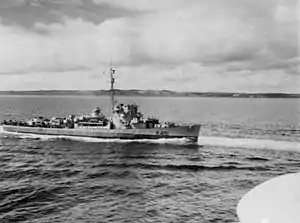HMS Gore
HMS Gore (K481) was a British Captain-class frigate of the Royal Navy in commission during World War II. Originally constructed as the United States Navy Evarts-class destroyer escort USS Herzog (DE-277), she served in the Royal Navy from 1943 to 1946.
 HMS Gore on 11 August 1944. | |
| History | |
|---|---|
| Name | USS Herzog (DE-277) |
| Namesake | U.S. Navy Lieutenant, junior grade, William Ralph Herzog (1909–1942), killed in action as commander of the Naval Armed Guard aboard SS Pan New York on 29 October 1942 |
| Ordered | 25 January 1942[1] |
| Builder | Boston Navy Yard, Boston, Massachusetts |
| Laid down | 20 May 1943 |
| Launched | 8 July 1943 |
| Completed | 14 October 1943 |
| Commissioned | never |
| Fate | Transferred to United Kingdom 14 October 1943 |
| Acquired | Returned by United Kingdom 2 May 1946 |
| Fate | Sold 19 November 1946 or 10 June 1947[3] for scrapping |
| Name | HMS Gore (K481) |
| Namesake | Admiral John Gore (1772–1836), British naval officer who was commanding officer of HMS Triton from 1796 to 1801 |
| Acquired | 14 October 1943 |
| Commissioned | 14 October 1943[1] |
| Fate | Returned to United States 2 May 1946 |
| General characteristics | |
| Displacement | 1,140 long tons (1,158 t) |
| Length | 289.5 ft (88.2 m) |
| Beam | 35 ft (11 m) |
| Draught | 9 ft (2.7 m) |
| Propulsion |
|
| Speed | 20 knots (37 km/h) |
| Range | 5,000 nautical miles (9,260 km) at 15 knots (28 km/h) |
| Complement | 156 |
| Sensors and processing systems |
|
| Armament |
|
| Notes | Pennant number K481 |
Construction and transfer
The ship was ordered on 25 January 1942[1] and laid down as USS Herzog (DE-277), the first ship of the name, by the Boston Navy Yard in Boston, Massachusetts, on 20 May 1943. She was launched on 8 July 1943. The United States transferred her to the United Kingdom under Lend-Lease on 14 October 1943.
Service history
The ship was commissioned into service in the Royal Navy as HMS Gore (K481) on 14 October 1943[1] simultaneously with her transfer. She served on patrol and escort duty.
On 26 February 1944, Gore joined the British frigates HMS Affleck (K462) and HMS Gould (K476) in a depth-charge attack that sank the German submarine U-91 in the North Atlantic Ocean at position 49°45′00″N 026°20′00″W.[1]
On 29 February 1944, Gore was operating as part of the First Escort Group when she, Affleck, Gould, and the British frigate HMS Garlies (K475) detected the German submarine U-358 in the North Atlantic north-northeast of the Azores and began a depth-charge attack which continued through the night and into 1 March 1944, the four frigates dropping a combined 104 depth charges. Gore and Garlies were forced to withdraw to Gibraltar to refuel on 1 March, but Affleck and Gould continued to attack U-358. During the afternoon of 1 March, U-358 succeeded in torpedoing and sinking Gould at position 45°46′00″N 023°16′00″W, but then was forced to surface after 38 hours submerged and was sunk by gunfire from Affleck at position 45°46′00″N 023°16′00″W.[1][4]
The Royal Navy returned Gore to the U.S. Navy on 2 May 1946.
Disposal
The U.S. Navy sold Gore on either 19 November 1946 or 10 June 1947[3] (sources vary) for scrapping.
Citations
References
- This article incorporates text from the public domain Dictionary of American Naval Fighting Ships. The entry can be found here. (USS Herzog)
- This article incorporates text from the public domain Dictionary of American Naval Fighting Ships. The entry can be found here. (HMS Gore)
- Navsource Online: Destroyer Escort Photo Archive Herzog (DE-277)/HMS Gore (K-481)
- uboat.net HMS Gore (K 481)
- Captain Class Frigate Association HMS Gore K481 (DE 277)